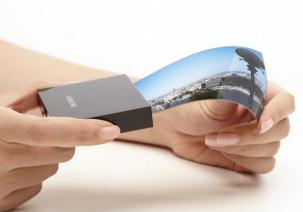In October 2013, following many years of development and prototype demonstrations, both Samsung and LG Display finally started producing flexible AMOLED displays on plastic (polyimide) substrates. Both Korean companies are now mass producing such displays, which are being used in mobile phones and wearable devices - such as the Galaxy S7 Edge (shown below), the LG G Flex 2 and Apple's Watch.
Samsung Display is currently producing flexible OLEDs in two production lines, the 5.5-Gen A2 and the and the newer A3 6-Gen A3. Samsung is producing around 9 million flexible OLEDs per month - to satisfy demand for its mobile phones and wearables - and Samsung is working on expanding its capacity as demand soars and as Apple ordered around 100 million flexible OLED panels for its future iPhones.
LG Display currently produces plastic-based OLEDs in its Gen-4.5 fab, and is investing $900 million to build new production lines as it also aims to become a major flexible AMOLED producer.

Flexible OLED lighting
OLEDs can also be used to make white lighting panels. OLED is a diffuse area lighting source with unique characteristics. While OLED lighting is still in its infancy, many believe that flexible OLED lighting panels may provide designers with a new lighting source that will create stunning designs. Currently there are two companies that produce flexible OLED lighting - LG Display who is also constructing the world's first Gen-5 OLED lighting mass production line and Konica Minolta who's also developing an amibitious flexible OLED lighting fab.



